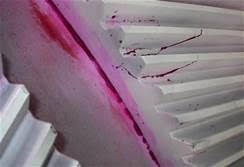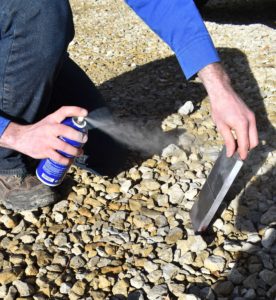
An Industrial Service Company offering a unique blend of services
1-855-227-5510
Email: [email protected]
XCEL
2755 State Hwy 322, Longview, TX 75603 | Mailing PO Box 8024, Longview, TX 75607
When testing for surface-breaking discontinuities, Liquid Penetrant Testing (PT) is a method that can be used on aluminum, magnesium, brass, copper, high quality castings, steel, stainless steel, carbides, certain plastics and ceramics.
The first and most important step in penetrant testing is to preclean the test surface to be examined. After precleaning, the penetrant is applied to the surface to be tested. The penetrant, which remains in a liquid form, is attracted into surface breaking flaws by capillary action. After the penetrant is allowed to dwell on the test surface for a predetermined amount of time, the excess penetrant on the surface is removed by either water wash or solvent wipe, depending on the type used. A developer is then applied to pull any penetrant trapped in discontinuities back to the surface where it forms an indication. The developer provides a highly contrasting white background to the deep red indications produced by visible dyes or to the bright green dyes used in fluorescent dyes.
Basic Steps in Liquid Penetrant Testing:
1) Precleaning
The test surface must be clean of all foreign materials. Dirt, oil, paint, rust, etc. could prevent the penetrant fropm properly covering the surface and ebntering discontinuities. Penetrant will not displace contaminants. The test piece must be completely clean and ample drying time must be allowed before applying the penetrant.
2) Application of the penetrant
There are two basic types of penetrants as defined by their visibility, Type I Fluorescent and Type II Visible. The types are further subdivided by the method of removal, Method A - Water Washable, Method B - Post Emulsified (Lipophilic), Method C - Solvent Removable, Method D - Post Emulsified (Hydrophilic) . All of these have their particular applications, strengths and weaknesses. Once this penetrant type is established, the penetrant is applied to the test surface in an even layer. It is very important that 100% of the area to be inspected has an adequate amount of penetrant applied to it. After the application, the penetrant is allowed to sit on the test piece for a predetermined amount of time known as dwell time.
3) Remove excess penetrant
Once the dwell time of the penetrant is complete, Remove the penetrant in the method prescribed for the type being used.
4) Apply developer
Developers are fine white powders that reverse the capillary action of discontinuities when present. The basic forms are water based, dry and non-aqueous wet. Again, the type of developer is selected based on several variables.
5) Inspection
Inspection of the test surface should take place immediately after the developer is applied, however the final inspection/analysis shall not be performed prior to a predetermined developing time in accordance with the applicable Code, standard or specification. If fluorescent dye is used, UV light as well as low ambient light levels would be necessary for final examination.
Defects will present contrasting “bleed out” or indications. The larger the void in the test part, the larger the indication will be. Defects such as tight cracks or lack of fusion will sometimes produce very small indications that have to be watched for closely.
6) Post Cleaning
The test surface may need to be cleaned after the inspection depending on the future service of the test piece.
Advantages of Liquid Penetration Testing
-
Large surface areas or large volumes of parts/materials can be inspected rapidly at low cost
-
Parts with complex geometry are routinely inspected
-
Indication(s) are produced directly on surface of the part helping to provide a visual image and location of the discontinuity
-
Non-ferromagnetic materials can be testing
Limitations of Liquid Penetration Testing:
-
Detects only surface breaking defects
-
Surface preparation is critical as contaminants can mask defects
-
Requires a relatively smooth and nonporous surface